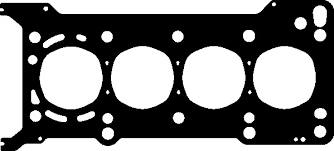-25%
Get Gasket cylinder Head for Mazda 2 and 3 ZJ01-10-271-A
A cylinder head gasket is a crucial component in an internal combustion engine, sitting between the engine block and the cylinder head. Its primary role is to seal the internal combustion process and ensure that oil and coolant do not mix within the engine. Here are the key benefits and functions of a cylinder head gasket:
1. Sealing the Combustion Chamber
The head gasket seals the combustion chamber, allowing the engine to build the necessary compression for the combustion process. This ensures optimal engine performance and efficiency.
2. Preventing Leaks
- Coolant and Oil: The gasket prevents the mixing of coolant and oil by sealing the passages that connect the engine block and the cylinder head. This separation is crucial because mixing these fluids can lead to engine failure.
- Compression Loss: By maintaining a tight seal around the combustion chambers, the gasket prevents the loss of compression, which can lead to reduced engine power and efficiency.
3. Heat Resistance
The gasket is designed to withstand the high temperatures and pressures within the engine. It prevents overheating by maintaining the integrity of the cooling system, which ensures that the engine operates within the optimal temperature range.
4. Durability and Longevity
Quality gaskets are made from durable materials that can withstand significant wear and tear, contributing to the overall longevity of the engine. This reduces the frequency of repairs and maintenance, saving time and costs in the long run.
5. Maintaining Engine Performance
By ensuring proper sealing and preventing leaks, the head gasket helps maintain consistent engine performance. It contributes to fuel efficiency, power output, and smooth engine operation.
6. Supporting Engine Structure
The gasket also contributes to the structural integrity of the engine by creating a tight seal between the engine block and the cylinder head. This helps maintain the correct alignment and pressure distribution within the engine.
7. Noise Reduction
A properly functioning head gasket helps reduce engine noise by ensuring that the combustion process is contained within the combustion chamber, leading to a quieter and smoother running engine.
Materials Used in Cylinder Head Gaskets
Head gaskets are typically made from several types of materials, each offering different benefits:
- Multi-Layer Steel (MLS): Common in modern engines, offering high durability and resistance to extreme conditions.
- Copper: Excellent for high-performance applications due to its superb thermal conductivity and durability.
- Composite: Made from materials like asbestos or graphite, now less common due to environmental and health concerns.
- Elastomeric: Incorporates rubber-like materials for better sealing properties and flexibility.
Key signs of a worn-out cylinder head gasket:
1. Overheating Engine
- Symptom: The engine frequently overheats.
- Cause: A blown head gasket can disrupt the cooling system by allowing coolant to leak into the combustion chamber or out of the engine, causing the engine to overheat.
2. White Smoke from the Exhaust
- Symptom: Continuous white smoke billowing from the exhaust.
- Cause: This indicates that coolant is leaking into the combustion chamber and being burned along with the fuel. This is a classic sign of a blown head gasket.
3. Loss of Coolant with No Visible Leak
- Symptom: The coolant level drops without any visible external leaks.
- Cause: The coolant might be leaking internally due to a head gasket failure, often into the combustion chamber or the oil passages.
4. Milky Oil
- Symptom: The engine oil appears milky or frothy, resembling a chocolate milkshake.
- Cause: This indicates that coolant is mixing with the oil due to a head gasket breach. This mixture reduces the oil’s effectiveness in lubricating the engine, which can lead to severe engine damage.
5. Bubbles in the Radiator or Coolant Reservoir
- Symptom: Bubbles appear in the radiator or coolant overflow tank, especially when the engine is running.
- Cause: Combustion gases escaping into the cooling system due to a head gasket leak cause bubbling.
6. Loss of Engine Power
- Symptom: The engine feels weaker and lacks the usual power.
- Cause: A leaking head gasket can result in loss of compression, leading to reduced engine power and performance.
7. Rough Idle or Misfiring Engine
- Symptom: The engine idles roughly or misfires, especially at startup.
- Cause: A head gasket leak can allow coolant or oil into the combustion chamber, causing improper combustion and misfires.
8. External Leaks
- Symptom: Visible coolant or oil leaks on the outside of the engine.
- Cause: A failed head gasket can allow fluids to escape externally, creating visible leaks.
9. Check Engine Light
- Symptom: The check engine light is illuminated on the dashboard.
- Cause: Sensor readings out of the normal range due to a head gasket issue can trigger the check engine light. This requires a diagnostic scan to confirm.
10. Unusual Engine Noises
- Symptom: Knocking or tapping sounds from the engine.
- Cause: Improper combustion due to a head gasket leak can cause unusual noises within the engine.
Diagnosing a Worn-Out Cylinder Head Gasket
To confirm a head gasket failure, several diagnostic tests can be performed:
- Compression Test: Measures the compression pressure in each cylinder. Low compression in one or more cylinders can indicate a head gasket issue.
- Cylinder Leak-Down Test: Pressurizes each cylinder to check for leaks into the cooling system, oil passages, or adjacent cylinders.
- Chemical Test for Combustion Gases in Coolant: Checks for the presence of combustion gases in the coolant, indicating a head gasket breach.
- Oil Analysis: Identifies coolant contamination in the oil.
Follow us on Facebook for more parts.



